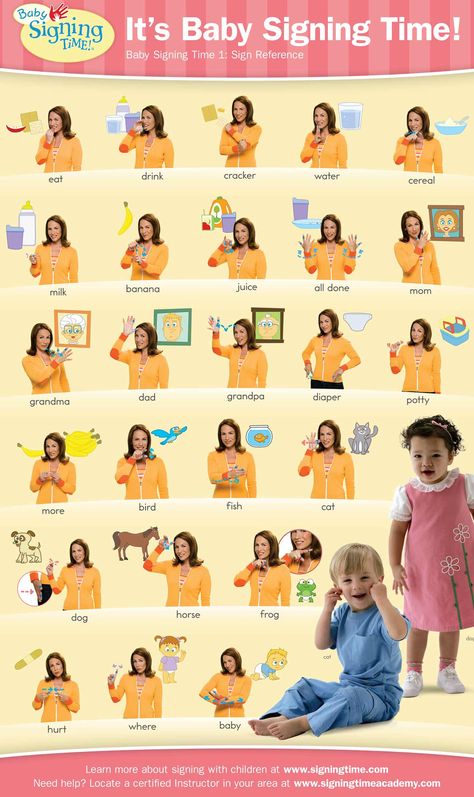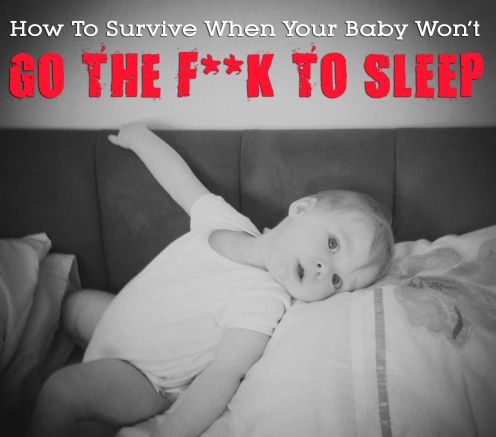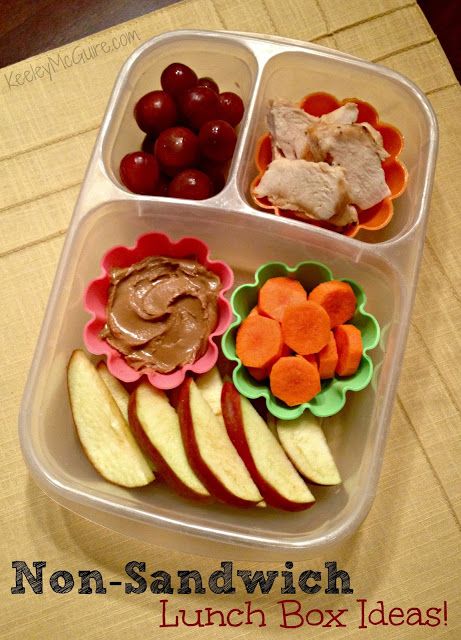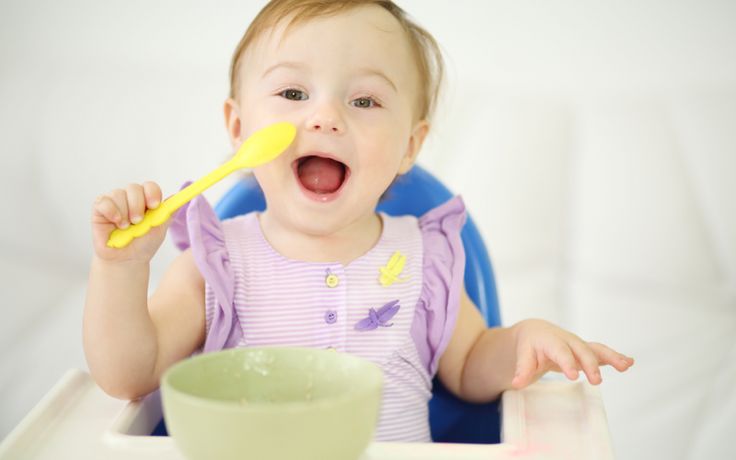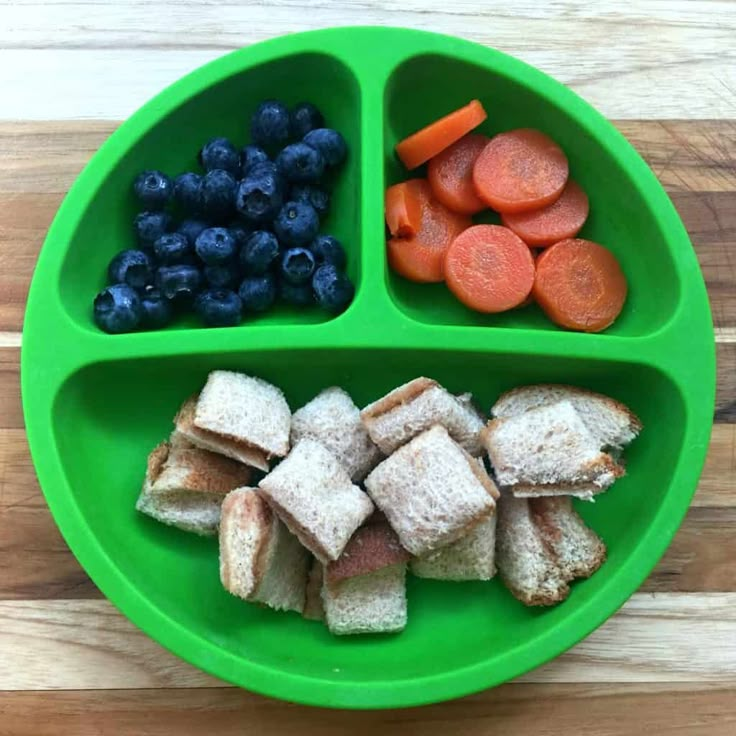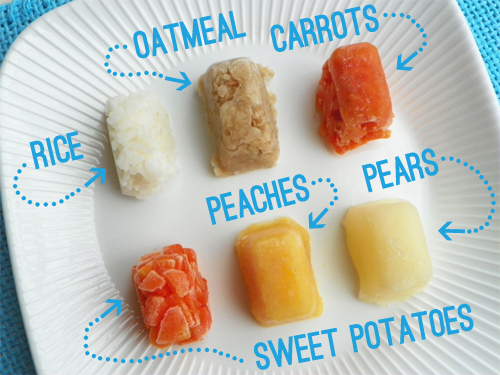Baby sign language for more food
25 Baby Signs to Know
We all hate seeing our kids unhappy—but when baby is too young to speak, it can be hard to know exactly what your little one wants. Are they hungry? Tired? Do they need a diaper change? Plus, it’s also probably just as frustrating for baby when their message just isn’t getting across. In recent years, more and more parents have been turning to baby sign language to help boost communication with their preverbal kids. Here, learn from experts what sign language for babies is, its benefits, how to start teaching it and 25 common baby signs to know.
In this article:
What is baby sign language?
Benefits of baby sign language Potential disadvantages of baby sign language How and when to start baby sign language
Common baby signs
Baby sign language chart
What Is Baby Sign Language?
Baby sign language is a set of simple hand gestures and movements, otherwise known as signs, that correspond to common words you use with baby every day. It’s a helpful tool to enhance communication between hearing parents and babies who can hear but can’t yet talk. Sometimes the baby signs are the same as those used in American Sign Language (ASL), but not always. “Baby sign is not a technical sign language, such as ASL or BSL (British sign language), which are primarily used by the deaf community and are more complex, with grammar and sentence structure,” says Jann Fujimoto, CCC-SLP, a certified speech-language pathologist in Wisconsin. “It’s a looser version that uses just signs for individual words.”
Academics began making powerful observations about how hearing families could benefit from using baby sign language around 200 years ago, thanks to the work of linguist William Dwight Whitney in the 1800s. But it wasn’t until the 2000s that baby sign language became readily available to parents through workshops, classes and baby sign language books.
Benefits of Baby Sign Language
Baby sign language is thought to offer a bunch of potential short-term and lasting benefits. Being able to understand what your preverbal baby wants or needs—and allowing baby to express themselves without the use of words—can go a long way in building your relationship. Some of the possible benefits of baby sign language are:
Being able to understand what your preverbal baby wants or needs—and allowing baby to express themselves without the use of words—can go a long way in building your relationship. Some of the possible benefits of baby sign language are:
- Increases baby’s ability to communicate before they can speak
- Leads to fewer tantrums, since baby can get their message across
- Lowers frustration for parents, since you can understand what baby wants or needs
- Gives baby a head start in language acquisition
- Strengthens baby’s cognitive skills
- Enhances parent-baby bonding
In the late 1980s, Linda Acredolo, a University of California, Davis professor, and Susan Goodwyn, a professor at University of Southern California, Stanislaus, found that babies who used baby sign language actually learned verbal skills faster than those who didn’t sign. In a second study, they later checked in on those same children at age 8 and found that the babies who used signs scored higher on IQ tests than the non-signers.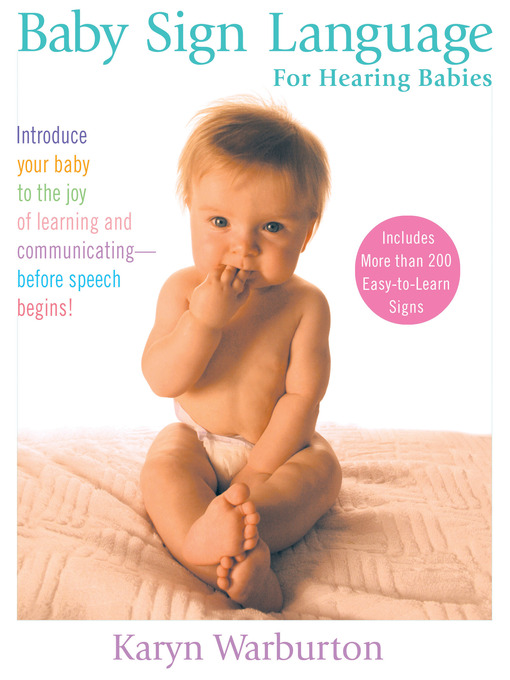
Shira Fogel, a speech pathologist who founded Tiny Talkers, a baby sign language workshop program in Portland, Oregon, became a believer in the benefits of sign language for babies after witnessing her first child’s remarkable progress. Her daughter made her first sign (milk) at 5.5 months, knew more than 100 signs at 12 months and could speak in full sentences by the time she was 18 months old. Even the American Academy of Pediatrics believes baby sign language can help bridge the communication gap and has given it its stamp of approval.
It’s worth noting, though, that not all academics agree that baby sign language offers proven benefits. While some studies (like the ones conducted by Acredolo and Goodwyn) have found significant upsides to using sign language for babies, other studies haven’t unearthed any significant or long-term differences between children who learn baby sign language and those who don’t. So in general, the benefits of baby sign are considered theoretical.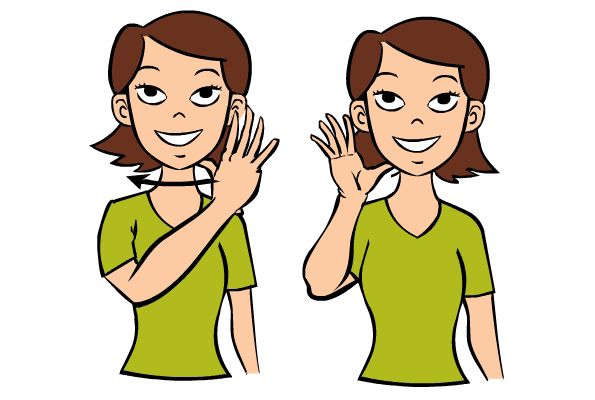
And, as Jack Maypole, MD, associate clinical professor of pediatrics at Boston Medical Center, points out, some benefits of baby sign language may be overstated and overpromised by the vast offerings of baby sign products on the market. “While learning baby sign language may help hearing parents and children communicate better, the results won’t necessarily be transformative, so be wary of programs that promise to get your child into Harvard or have their first novel published by nursery school,” Maypole says.
Potential Disadvantages of Baby Sign Language
So you’ve brushed up on the possible benefits of sign language for babies—but what about potential downsides? Since baby can begin to communicate using signs instead of spoken words, many parents wonder—does baby sign language delay speech? Fujimoto says no. If baby is developing at a healthy pace, baby sign just supplements their learning and gives them another way to express themselves. If you think baby might actually have a hearing impairment, don’t just rely on baby sign language as a solution, she adds.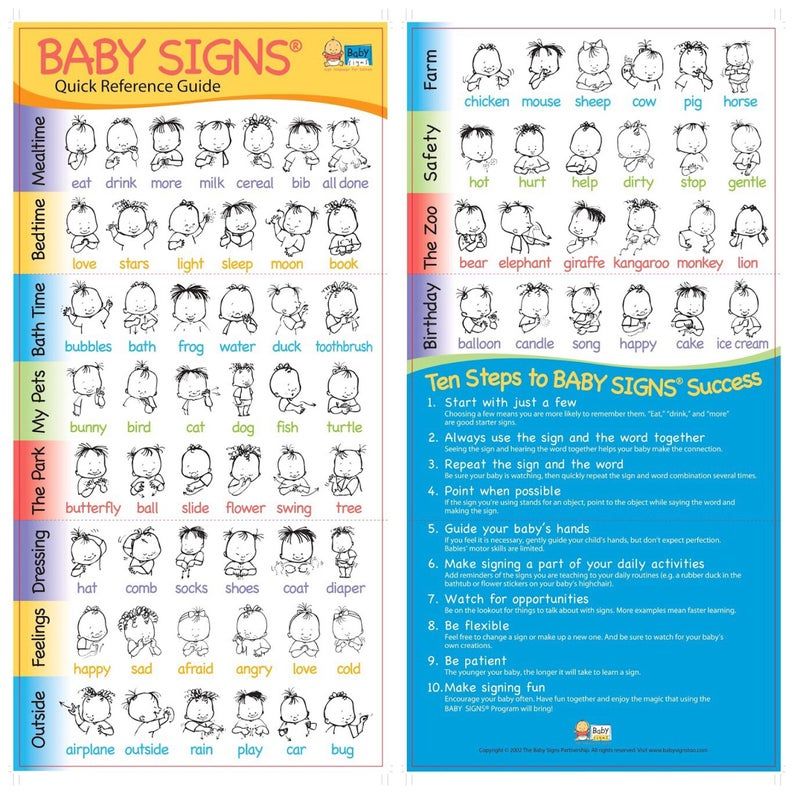 Talk to your pediatrician about your concerns and ask about referrals to an audiologist, who can perform the proper hearing tests and assessments.
Talk to your pediatrician about your concerns and ask about referrals to an audiologist, who can perform the proper hearing tests and assessments.
How and When to Start Baby Sign Language
If you’ve decided to give baby sign language a go, you may be wondering when to teach baby some signs. A good time to start is when baby is 4 to 6 months old, according to Fujimoto. As for how, there are many different approaches to teaching baby sign language, but generally, you can teach baby by saying a word like “milk,” while making the sign at the same time, and then giving baby the milk. “Don’t hold out the item as a prize and refuse to hand it over until your child makes the sign himself,” Fujimoto says. “Verbal reinforcement—by saying the word while also showing the sign—as well as consistency are key.”
As part of the consistency, you’ll want to use the signs every day for baby to truly understand them. While your little one likely won’t start making signs on their own until they’re about 6 to 9 months, eventually baby will start to make connections between the word, sign and item. Just like learning a foreign language, a preverbal baby is going to understand more than they can speak—or in this case, sign—at first.
Just like learning a foreign language, a preverbal baby is going to understand more than they can speak—or in this case, sign—at first.
For more resources, parents can turn to the many workshops, videos, books and apps available these days, all designed to help you teach sign language for babies. A typical class or workshop may teach parents 30 to 50 different signs you can then use with baby at your own pace. “Some families with older babies may learn best by singing along with a video, or attending a class together,” Fujimoto says. “Families should find the method that makes sense for them.”
Common Baby Signs
When you’re ready to begin teaching baby sign language, you’ll need to decide which baby signs to start with. Fujimoto says to choose the words you and your family use the most on a day-to-day basis, like “more,” “please” and “milk.” Ready to learn how to teach baby sign language? Brush up on the below illustrations of 25 common baby signs.
Image: Kitkat Pecson
“Hungry” in sign language
It’s important for baby to be able to communicate when they’re tummy feels empty—you know, before they get hangry. Teach them how to show you they’re “hungry” in sign language. You can make the sign for “hungry” by cupping your hand around your neck to make a C shape, then move your hand down from your neck to your stomach.
Teach them how to show you they’re “hungry” in sign language. You can make the sign for “hungry” by cupping your hand around your neck to make a C shape, then move your hand down from your neck to your stomach.
Image: Kitkat Pecson
“Drink” in sign language
Want to learn how to sign “drink” in sign language? This one involves mimicking the action! Make a C shape with your hand, as if you were holding a cup, then move it to your mouth as if you were drinking from it.
Image: Kitkat Pecson
“Milk” in sign language
Wondering how to teach baby sign language? It’s best to start with something baby knows, likes and wants—for example, milk. You can communicate the word “milk” in sign language, by making two fists, then extend your fingers and bring them back into fists.
Image: Kitkat Pecson
“Water” in sign language
Teach baby how to request “water” in sign language, and you’ll always know when your little one wants their sippy cup. The sign for “water” is made by extending your three middle fingers so they’re pointing up, with your thumb and pinkie tucked down, and then tapping your index finger to your chin.
The sign for “water” is made by extending your three middle fingers so they’re pointing up, with your thumb and pinkie tucked down, and then tapping your index finger to your chin.
Image: Kitkat Pecson
“More” in sign language
Do you have trouble knowing if and when baby wants extra spoonfuls of their favorite puree? “More” is another important word for you and baby to learn. To express “more” in sign language, pinch your thumbs and fingers together on both hands, creating two O shapes, then tapping your fingertips together a few times.
Image: Kitkat Pecson
“Done” in sign language
When baby is full, they want you to stop shoving that spoon toward their mouth. Teach them to let you know they’re “all done” without fussing by using the ASL sign for “finished.” Start with your hands up, palms facing toward you, and turn them until your palms face out.
Image: Kitkat Pecson
“Play” in sign language
When it comes to baby sign language, the sign “play” certainly belongs in your arsenal.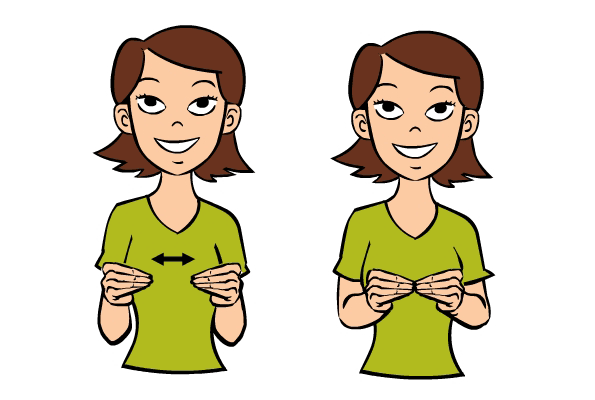 To communicate “play” in sign language, clench your fingers to your palms, leaving your thumbs and pinkies extended; then with palms facing you, twist your wrists back and forth.
To communicate “play” in sign language, clench your fingers to your palms, leaving your thumbs and pinkies extended; then with palms facing you, twist your wrists back and forth.
Image: Kitkat Pecson
“Sleep” in sign language
Nobody likes having a fussy, sleep-deprived baby on their hands, so it’s a good idea to practice “sleep” in sign language. Hold your hand over your forehead with your fingers spread apart, then draw your hand down over your face until your fingers and thumb come together to touch your chin. Even babies who resist nap time may whip this one out when they’re especially exhausted.
Image: Kitkat Pecson
“Mom” in sign language
Your little one will want to know how to address their favorite people in baby sign language. To sign “mom,” simply spread your fingers apart, then with your pinkie facing forward, tap your thumb to your chin.
Image: Kitkat Pecson
“Dad” in sign language
As another one of baby’s favorite people, Dad will want in on the fun too! You can make the sign for “dad” by spreading your fingers apart, then with your pinkie facing forward, tap your thumb to your forehead.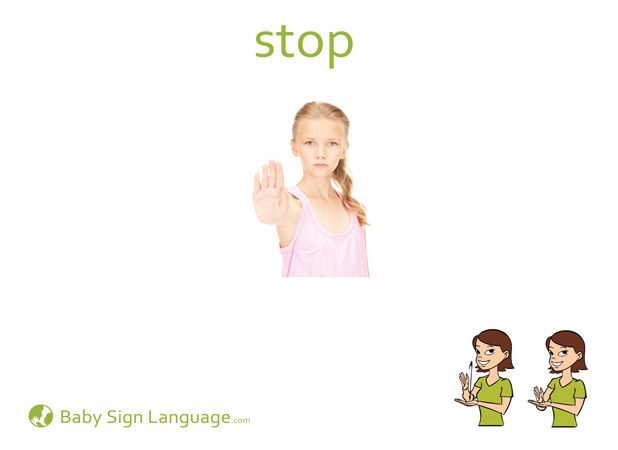
Image: Kitkat Pecson
“Poop” in sign language
Everybody does it, so you might as well learn to sign it! If you want to indicate “poop” in sign language, clench both hands into fists and stack them on top of each other, with the thumb of the bottom hand tucked inside the upper fist. Then, pull your bottom hand down from the upper hand, leaving your thumb extended. Next time baby soils their diaper, they’ll let you know—before you even smell it.
Image: Kitkat Pecson
“Yes” in sign language
Another easy and important sign to learn is “yes.” Enthusiastically nodding your head is great, but this sign gives baby yet another communication tool. Intuitively, “yes” in sign language looks just like a nodding hand. Make a fist and then, folding at your wrist, bob your fist up and down.
Image: Kitkat Pecson
“No” in sign language
Again, shaking your head works, but this sign helps reiterate the point. To express “no” in sign language, extend your thumb, index and middle fingers, then quickly snap them together.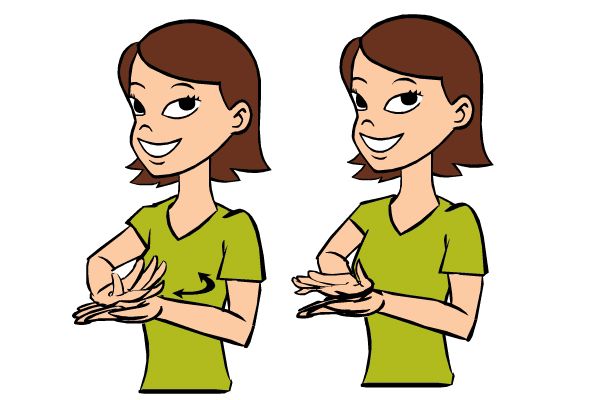
Image: Kitkat Pecson
“Food” in sign language
Instead of signing “hungry,” baby may want to ask for “food.” This sign can also mean “eat.” Communicate “food” in sign language by flattening your fingers on top of your thumb and then bringing your fingertips to your mouth.
Image: Kitkat Pecson
“Help” in sign language
When learning and teaching baby sign language, be sure to review the sign for “help.” This can be useful to baby in so many different situations; plus, being able to ask for support from a parent or caregiver can help reduce any frustration a baby may feel. If you want to communicate “help” in sign language, simply make a fist with one hand, with the thumb extended, and place it over your other hand, which is extended flat. Then move both hands up together.
Image: Kitkat Pecson
“Bath” in sign language
Want to tell baby it’s bath time? Express ‘“bath” in sign language by making two fists, then moving them up and down in front of your chest (as if you were scrubbing yourself clean).
Image: Kitkat Pecson
“Book” in sign language
Storytime is the best time! Use your hands to say “book” in sign language; clasp your palms together with your thumbs facing up, then hinge open your hands, keeping your pinkies together (as if you were cracking open a book).
Image: Kitkat Pecson
“Medicine” in sign language
The sign for “medicine” is made by placing your middle finger into the palm of your opposite hand and twisting.
Image: Kitkat Pecson
“Share” in sign language
To sign “share,” extend one hand flat, with your thumb pointing up. Then, run your other hand back and forth along the top of your extended fingers.
Image: Kitkat Pecson
“Sorry” in sign language
Teach baby to show empathy and express feelings before they know how to do it verbally. The sign for “sorry” is made by rubbing a fisted hand in a circle over your chest.
Image: Kitkat Pecson
“Please” in sign language
Manners matter. Teach baby to ask for things politely from the get-go. To sign “please,” extend your fingers and thumb out, then rub your flattened palm against your chest in circles.
Teach baby to ask for things politely from the get-go. To sign “please,” extend your fingers and thumb out, then rub your flattened palm against your chest in circles.
Image: Kitkat Pecson
“Thank you” in sign language
Nothing is sweeter than watching your little one express gratitude. And they’ll appreciate it when you show them the same respect and courtesy right back. To sign “thank you,” straighten your thumb and fingers, then bring your fingers to your chin and pull them away.
Image: Kitkat Pecson
“You’re welcome” in sign language
The sign for “you’re welcome” is the same as the sign for “thank you”—flatten your hand, bring your fingers to your chin and pull them back.
Image: Kitkat Pecson
“I love you” in sign language
This is one sign you’re going to both want to use all the time. To sign “I love you,” extend your thumb, index and pinkie fingers (but keep your ring and middle fingers down). Hold your hand out with the palm facing away and rotate your hand side to side.
Image: Kitkat Pecson
“Hurt” in sign language
The baby sign for “hurt” is done by clenching both hands into fists, then extending your index fingers and touching them together.
Baby Sign Language Chart
Here, you can see 25 of the most common signs, all in one comprehensive baby sign language chart.
Image: Kitkat Pecson
Now that you know the basics of how to teach baby sign language, begin practicing a few words you think you’ll use most frequently at home. Your little one will love having a special way to communicate their wants and needs with you. What’s more, having the ability to express your feelings to each other will help strengthen your bond. It’s a win-win!
About the experts:
Jann Fujimoto, CCC-SLP, is a certified speech-language pathologist in Wisconsin. With 17 years of experience, she has worked in birth-to-three programs, pre-schools and schools, hospitals, skilled nursing facilities and outpatient clinics. She received her MS in communication disorders from the University of Texas at Dallas.
She received her MS in communication disorders from the University of Texas at Dallas.
Jack Maypole, MD, is an associate clinical professor of pediatrics at Boston Medical Center and a pediatrician with over two decades of experience. He received his bachelor’s degree from Yale University and his medical degree from Yale University School of Medicine.
Please note: The Bump and the materials and information it contains are not intended to, and do not constitute, medical or other health advice or diagnosis and should not be used as such. You should always consult with a qualified physician or health professional about your specific circumstances.
Plus, more from The Bump:
When Do Babies Start Talking
How Should I Be Talking to Baby
11 Best Baby Book Subscriptions for Expanding Little Minds
How To Teach Your Baby Sign Language
Just because your little one can’t talk yet, doesn’t mean you can’t communicate with them! Here’s how I taught my baby sign language.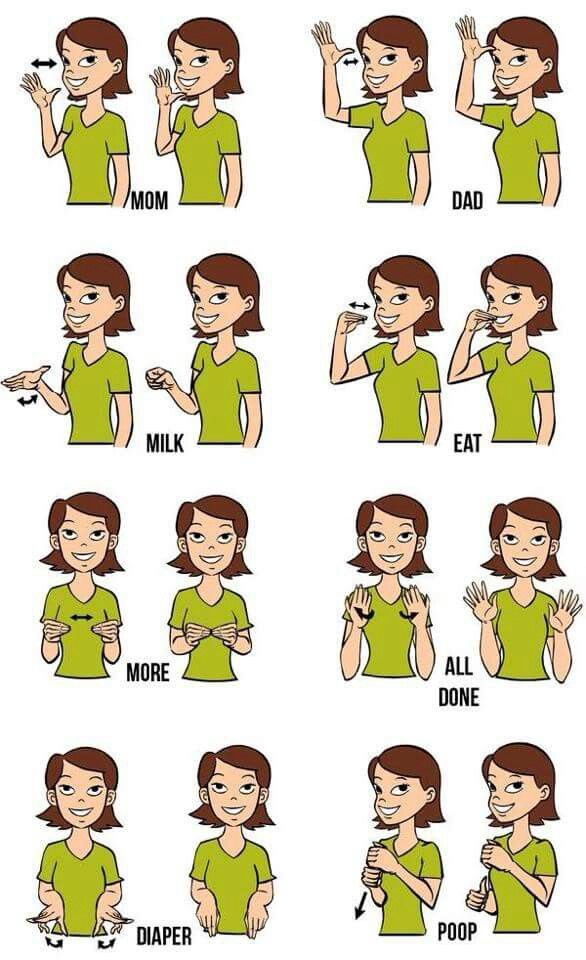
Baby sign language has been awesome for us. It’s been a great way to communicate with our daughter Sage even though she can’t talk yet – although she’s MASTERING the word ‘no’! Having signals we can use to ‘speak’ to her without words has been super helpful because it saves having to guess what she wants. It reduces frustration for both of us, and it was surprisingly easy to teach her. One of the top questions I get asked over on my Instagram is how I taught Sage sign language, so here we go!
What is baby sign language?
Baby sign language is a set of simple hand gestures (AKA signs) that mean common words such as ‘more’, ‘all done’ and ‘milk’. You can use them with your baby to ask questions (for example, “Would you like more?”) and your baby can use them to answer you. It’s basically a way to communicate with your baby before they learn how to speak.
What are the benefits of baby sign language?
There are so many benefits to teaching your baby sign language. It builds confidence, it encourages their drive to learn and it reduces frustration when it comes to communication. On top of all that, signing with your baby means you’ll naturally be talking to them way more than you might otherwise, which will only help to teach them to speak in the long run.
It builds confidence, it encourages their drive to learn and it reduces frustration when it comes to communication. On top of all that, signing with your baby means you’ll naturally be talking to them way more than you might otherwise, which will only help to teach them to speak in the long run.
Is baby sign language the same as ASL?
Not necessarily. ASL, or American Sign Language, is a complete language. There’s complex rules to do with grammar and word order, whereas baby sign language is very basic. After all, if you’re teaching it to a baby, it’s got to be simple enough for them to learn!
What age should you start doing baby sign language?
I didn’t do a whole lot of research before I started teaching Sage, but I did start young. She was about six months old – right around the time we started feeding her solids. This age worked really well because a lot of the signs correspond to food. I wouldn’t worry if your little one is older than 6 months though. They can pick it up at any time!
How to teach a baby sign language
Repetition is key.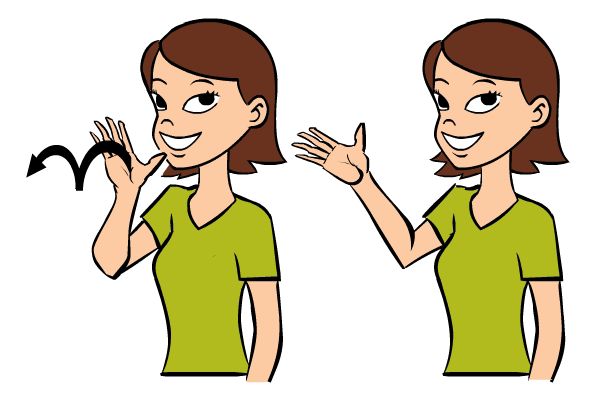 Any time I’m trying to teach Sage a new sign, I just repeat it again and again. So, for example, when I wanted to teach her the sign for ‘milk’, I’d do the sign while saying the word, and then I’d give her milk. When I wanted to teach her ‘more’, I’d ask her “Do you want more?” while doing the sign, and then I’d give her more.
Any time I’m trying to teach Sage a new sign, I just repeat it again and again. So, for example, when I wanted to teach her the sign for ‘milk’, I’d do the sign while saying the word, and then I’d give her milk. When I wanted to teach her ‘more’, I’d ask her “Do you want more?” while doing the sign, and then I’d give her more.
Once I’d done it myself a few times, I started taking her hands and showing her how to do the signs. She might try to do it with my hands at first, or to do it on me. Just have fun with it and they’ll pick it up eventually. We’re working on a few new signs right now like ‘please’ and ‘water’, and I’ve recently picked up this book which I’m excited to try.
The other thing I’d suggest is not being too strict about the actual signs. The sign for ‘all done’ is kind of tricky for young babies to do in my opinion, so just waving both hands worked way better for us. As long as you understand it and your baby understands it, that’s all that matters. They can perfect it as they get older.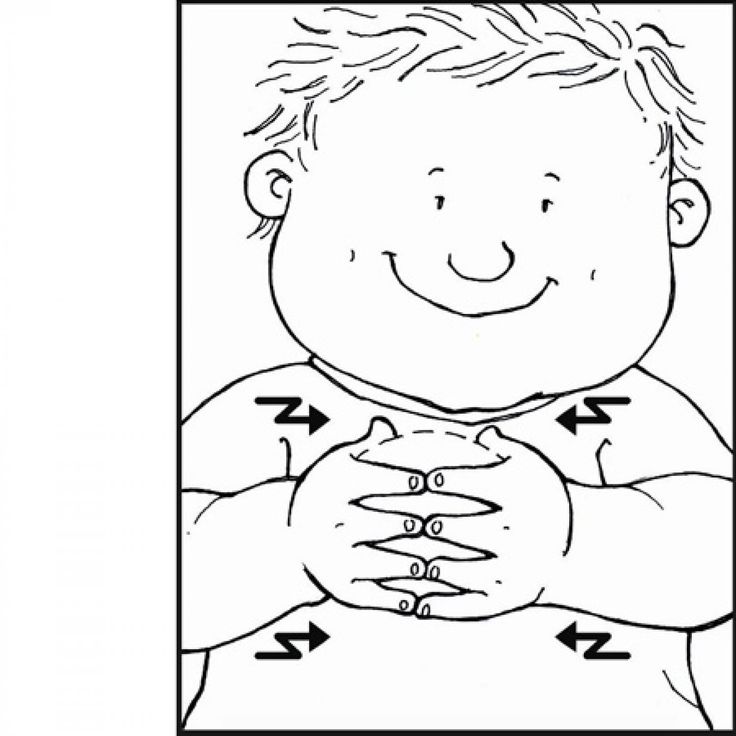
My top tips would be…
- Reward or show a positive response when your baby uses sign language
- Have the whole family use it with baby
- Use it throughout everyday life, not just with food. “More” can also mean “keep playing”
- Sign in front of a mirror so baby can see what they are doing
- Start early
- Be consistent and repeat, repeat, repeat!
Common baby signs we taught Sage
There are a ton of baby signs out there, but here are the ones we taught Sage to begin with…
Milk
Milk was a really good one to start with, because she seems to catch on easiest when it’s something she really loves. Once she had milk down, she understood the idea of signing and so the others were easier to pick up. If you’re consistent with it, you’ll see one day they just ‘get it’. To sign ‘milk’, make two fists with thumbs pointing up, then stretch out your fingers and bring them back into fists.
More
I often only give Sage half of her meal to begin with, and keep the rest separate.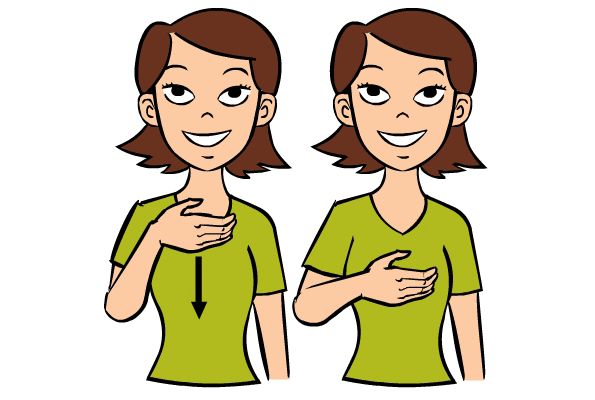 Then, once she’s finished what’s on her plate, she can ask for more. To sign ‘more’, pinch your thumbs and fingers together on both hands, then tap your fingertips together a few times.
Then, once she’s finished what’s on her plate, she can ask for more. To sign ‘more’, pinch your thumbs and fingers together on both hands, then tap your fingertips together a few times.
All done
As I said, we don’t strictly do this one correctly. To sign ‘all done’, you’re meant to start with your palms facing towards you and turn them until your palms face outwards. This was a bit tricky for Sage, so we just wave our hands in the air to signal all done.
Have you ever tried baby sign language? Let me know your favourite signs in the comments below!
If you’re preparing to start your baby on solid foods, you may also want to check out my Baby Food Resources I’ve Been Loving post and my 6-8 Month Meal Plan.
Hey, I’m Nikole!
Aka the “HealthNut”
behind HealthNut Nutrition.
I live in Canada with my other
half, Matt or as he’s known on
the internet “Mr.Matt” with our
newly adopted pup Cashew!
Read More
Connect with me!
Subscribe
You Donut want to miss out on the HealthNut newsletter!Recent Videos
Subscribe to the YouTube channel and join the 724k and growing HealthNut Fam community!
Let’s Go!
Shop
Kitchen Essentials
Let’s Go!
Get the
Green Smoothie Guide
Get it!
Shop
Digital Products
Let’s Go!
Free!
Natural Skin Care Cheat Sheet
Get it!
Shop Now
My Favourites
On Amazon
Reducing salt intake
Reducing salt intake- Popular Topics
- Air pollution
- Coronavirus disease (COVID-19)
- Hepatitis
- Data and statistics »
- News bulletin
- The facts are clear
- Publications
- Find country »
- A
- B
- C
- g
- D 9000 T
- in
- F
- x
- C 9000 WHO in countries »
- Reporting
- Regions »
- Africa
- America
- Southeast Asia
- Europe
- Eastern Mediterranean
- Western Pacific
- Media Center
- Press releases
- Statements
- Media messages
- Comments
- Reporting
- Online Q&A
- Developments
- Photo reports
- Questions and answers
- Update
- Emergencies "
- News "
- Disease Outbreak News
- WHO Data »
- Dashboards »
- COVID-19 Monitoring Dashboard
- Basic moments "
- About WHO »
- CEO
- About WHO
- WHO activities
- Where does WHO work?
- Governing Bodies »
- World Health Assembly
- Executive committee
- Main page/
- Media Center /
- Newsletters/
- Read more/
- Reducing salt intake
WHO/S.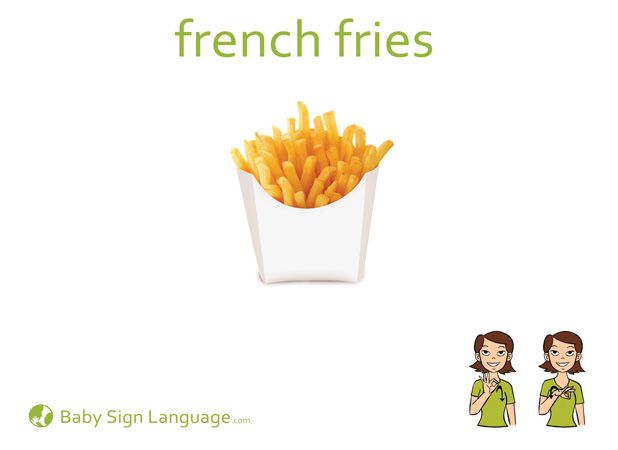 Volkov
Volkov
© A photo
Key Facts
- High sodium intake (more than 2 grams per day, equivalent to 5 grams of salt per day) and insufficient intake of potassium (less than 3.5 grams per day) contribute to high blood pressure and increase the risk of heart disease. - vascular disease and stroke.
- The main source of sodium in our diet is salt, although it can also come from monosodium glutamate, which is used as a food flavoring in many countries.
- Most people consume too much salt: an average of 9-12 grams per day, or about twice the recommended maximum intake.
- In adults, less than 5 grams of salt per day can help lower blood pressure and reduce the risk of heart disease, stroke, and heart attack. The main benefit of reducing salt intake is the corresponding reduction in high blood pressure.
- WHO Member States have agreed to reduce global salt intake by 30% by 2025.
- Reducing salt intake is recognized as one of the most cost-effective measures that countries can take to improve public health outcomes.
 At a cost below average annual income or gross domestic product per capita, key measures to reduce salt intake will win another year of healthy living.
At a cost below average annual income or gross domestic product per capita, key measures to reduce salt intake will win another year of healthy living. - It is estimated that reducing salt intake to the recommended level would prevent 2.5 million deaths each year.
Increasingly processed food production, rapid urbanization and changing lifestyles are changing dietary trends. The availability and affordability of products that have undergone deep technological processing are increasing. Populations around the world are consuming more and more high-calorie foods that are high in saturated fats, trans fats, sugars and salt. Salt is a major source of sodium, and increased sodium intake has been linked and hypertension, as well as an increased risk of cardiovascular disease and stroke.
At the same time, as we move away from habitual eating patterns, the consumption of key components of a healthy diet - fruits, vegetables and dietary fibers (in particular, whole grains) - decreases. Fruits and vegetables contain potassium, which helps lower blood pressure. pressure.
Fruits and vegetables contain potassium, which helps lower blood pressure. pressure.
The role of processed foods as a source of salt in the diet is explained by the fact that their salt content is particularly high (in the case of prepared meals, meat products such as bacon, ham and cold cuts, cheeses, salted snacks, instant noodles cooking, etc.), as well as the fact that they are consumed frequently and in large quantities (in the case of bread and processed cereals). Salt is also added to food during cooking (in the form of bouillon cubes) or already at the table (in the form of soy or fish sauce and table salt).
However, many manufacturers are reformulating their products to reduce the salt content, and consumers are advised to pay attention to product labels and choose low-sodium products.
Salt reduction advice
- Adults. The WHO recommends that adults consume less than 5 grams of salt per day (just under one teaspoon) (1).
- Children.
 For children aged 2 to 15 years, WHO recommends adjusting the recommended maximum salt intake downwards based on their energy needs compared to adults. This recommendation for children is not covers the period of exclusive breastfeeding (0-6 months) or the period of complementary feeding while continuing breastfeeding (6-24 months).
For children aged 2 to 15 years, WHO recommends adjusting the recommended maximum salt intake downwards based on their energy needs compared to adults. This recommendation for children is not covers the period of exclusive breastfeeding (0-6 months) or the period of complementary feeding while continuing breastfeeding (6-24 months). - All salt consumed must be iodized. fortified with iodine, which is essential for the healthy development of the brain in the fetus and young children and the general strengthening of mental functions in all people.
Salt, Sodium and Potassium Information
- Sodium is an essential nutrient needed to maintain plasma volume and water-alkaline balance, transmission of nerve impulses and normal cell function.
- Excess sodium is associated with negative health effects, including increased blood pressure.
- The main sources of sodium intake in food are determined by the cultural characteristics and culinary preferences of the population.
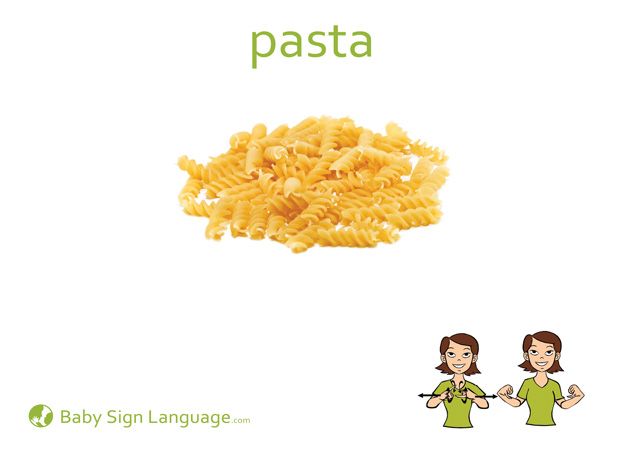
- Sodium is found naturally in a wide range of foods such as milk, meat and seafood. It is often found in high amounts in processed foods such as baked goods, meat products and snacks, and also in flavoring food additives (for example, soy and fish sauces).
- Sodium is also found in monosodium glutamate, which is used as a dietary supplement in many parts of the world.
- Potassium is an essential micronutrient needed to maintain total body fluids, acid and water-electrolyte balance, and normal cell function.
- Potassium is found in a wide variety of unprocessed foods, especially fruits and vegetables.
- Increased potassium intake has been shown to reduce systolic and diastolic blood pressure in adults.
How to reduce salt intake in food
Public policies and strategies should ensure that the population can consume sufficient amounts of safe and nutritious foods that form the basis of a healthy diet, which include foods with low content salt.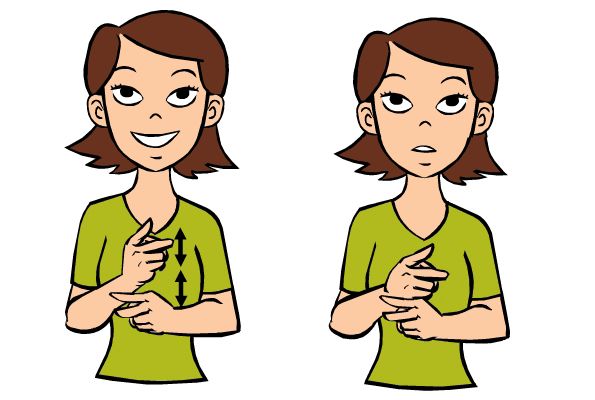 Improving eating habits is not only the responsibility of society, but of every individual. This must be done in a way that takes into account the characteristics and cultures of the population and involves a range of sectors.
Improving eating habits is not only the responsibility of society, but of every individual. This must be done in a way that takes into account the characteristics and cultures of the population and involves a range of sectors.
Key general strategies to reduce salt intake include:
- government policies, including appropriate tax policies and regulations, to ensure that manufacturers and retailers supply healthier foods and expand the range of affordable and affordable healthy foods;
- engaging with the private sector to ensure the supply and availability of low-salt foods;
- informing and empowering consumers through social marketing and mobilization to raise awareness of the need to reduce salt intake;
- creating an enabling environment for salt reduction through local policy initiatives and promoting “healthy eating environments”, in particular at school, community and city levels;
- Monitor population salt intake, dietary salt sources, and people's awareness, attitudes and behaviors about the issue to inform policy decisions.

Salt reduction programs and micronutrient fortification programs for salt, flavorings, and high-salt condiments (bouillon cubes, soy sauce, and fish sauce) can complement each other.
Salt intake at home can be reduced if:
- do not add salt to meals during cooking;
- do not keep a salt shaker on the dining table;
- limit consumption of salty snacks;
- choose foods low in sodium.
A number of other local practices contribute to reducing salt intake:
- including salt reduction in training programs for food and food service workers;
- removal of salt shakers and soy sauce from tables in catering establishments; posting notices that certain products are high in sodium on packaging or on store shelves;
- providing special dietary advice to health facility visitors;
- explanatory work on the need to reduce salt intake and limit its use in cooking;
- outreach to children and creating an environment for children to develop the habit of a low-salt diet at a young age.
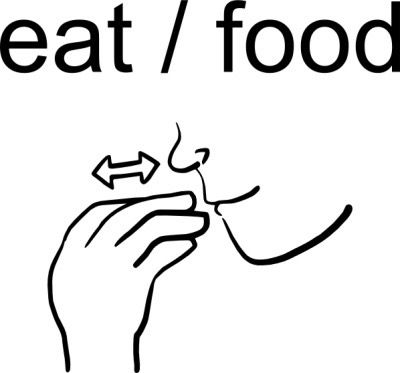
Food industry actions should include:
- gradually reducing the salt content of products over time so that consumers become accustomed to its taste gradually, without switching to alternative products;
- Promoting the benefits of eating low-salt foods through consumer information activities in food service establishments and shops;
- Reducing the salt content of foods and dishes offered by restaurants and food services, and indicating their sodium content.
Misconceptions about reducing salt intake
- "On a hot and humid day, a person sweats, and his food should have more salt." When sweating, the body loses very little salt, so even in conditions of heat and high humidity, excess salt is not needed; however, abundant drink.
- Sea salt is not "healthier" than commercially produced salt just because it is "made by nature." Regardless of the origin of salt, its sodium content causes negative health effects.
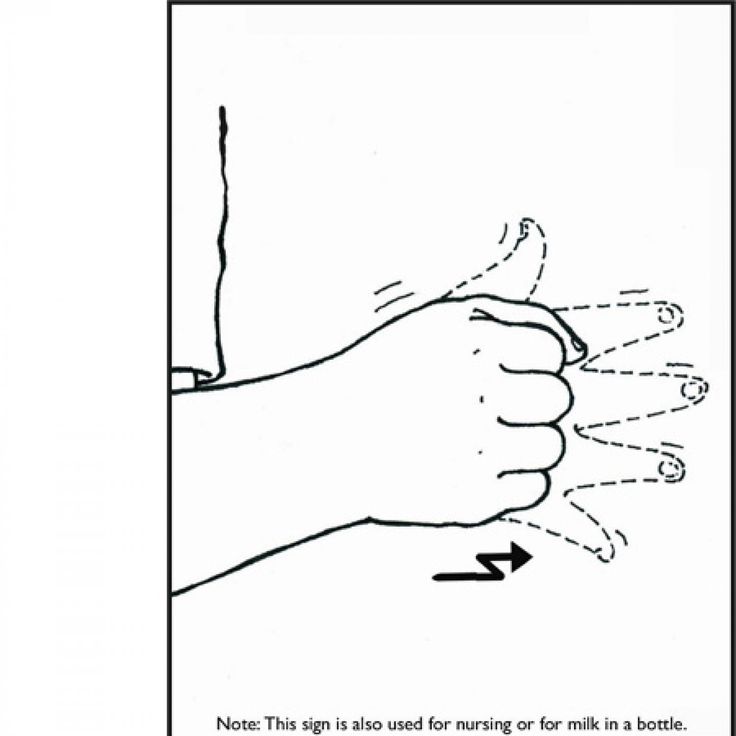
- Adding salt to food is not the main source of salt intake. In many countries, approximately 80% of dietary salt is consumed as part of industrially processed foods.
- You don't have to use salt to make your food taste good. A person's taste buds do not adapt immediately, but once they become accustomed to reduced salt intake, they are more likely to enjoy food and feel wider range of flavors.
- "Food without salt seems bland." This may be true at first, but soon the taste buds adapt to the reduced salt content, and the person becomes accustomed to appreciating less salty but more flavorful foods.
- "Food with a lot of salt that tastes salty." Some high-salt foods do not have a pronounced salty taste because they are combined with other salt-masking ingredients, such as sugars. To find out the sodium content of foods, you need to pay attention to the labels.
- "Only the elderly should worry about the amount of salt they consume.
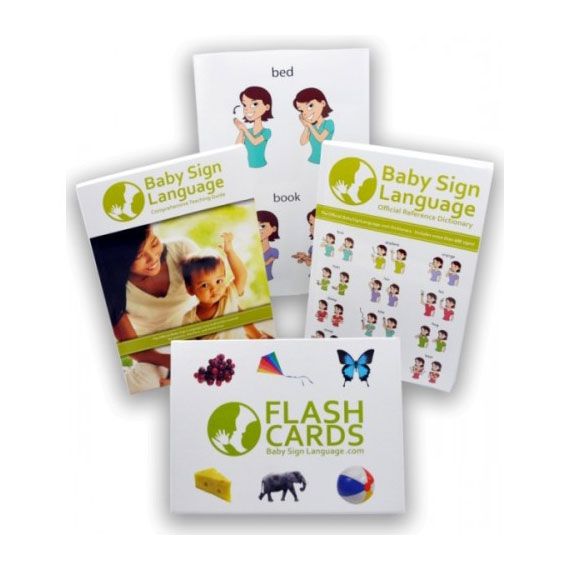 " Excessive salt intake can lead to high blood pressure in people of all ages.
" Excessive salt intake can lead to high blood pressure in people of all ages. - "Reducing my salt intake can be bad for my health." It is very difficult to consume too little salt because it is found in a large number of everyday foods.
WHO activities
WHO guidelines on sodium and potassium intake set limits for their intake without compromising health. The guidelines also describe interventions to improve nutrition and prevent NCDs in adults and children.
In 2004, the World Health Assembly adopted the Global Strategy on Diet, Physical Activity and Health. It calls on governments, WHO, international partners, the private sector and civil society to take action support for healthy eating and physical activity at the global, regional and local levels.
In 2010, the World Health Assembly approved a set of guidelines for marketing food and non-alcoholic beverages to children. The recommendations guide countries in developing new and strengthening existing policy measures to reduce the negative impact of unhealthy food marketing on children.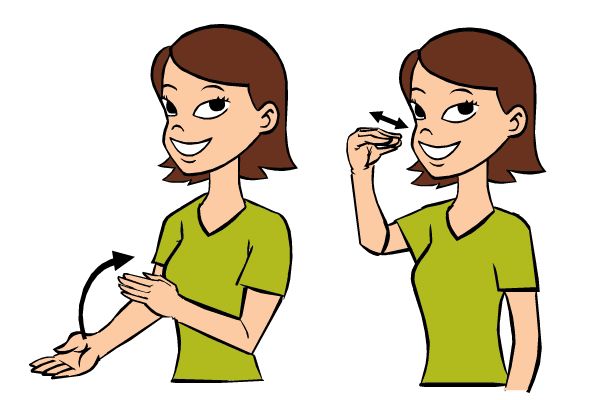 WHO is also supporting the development of a nutrient profile model that can be used by countries as a tool in implementing marketing recommendations.
WHO is also supporting the development of a nutrient profile model that can be used by countries as a tool in implementing marketing recommendations.
In 2011, world leaders committed to reducing the negative impact of unhealthy diets on people. This commitment was proclaimed in the Political Declaration of the High-Level Meeting of the General Assembly on Prevention NCDs and their control.
In 2012, the World Health Assembly approved six global nutrition goals, including reducing the number of children who are stunted, wasted and obese, increasing breastfeeding rates and reducing cases of anemia and low birth weight.
In 2013, the World Health Assembly agreed on nine global voluntary targets for the prevention and control of NCDs, including halting the spread of diabetes and obesity and reducing the consumption of salt by 30% by 2025 Global action plan for the prevention and control of noncommunicable diseases 2013–2020 provides guidance and a set of policy options for achieving these goals by Member States, WHO and other UN agencies.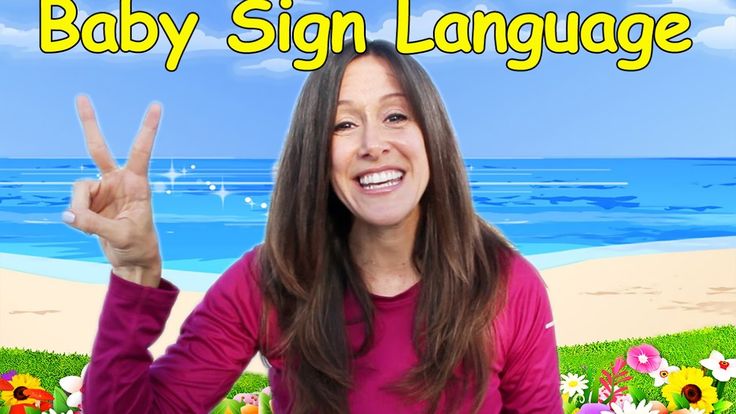
In May 2014, in response to the rapid increase in the prevalence of obesity among infants and children, WHO established the Commission to End Childhood Obesity. The Commission prepared a report for 2015, in which it clarified which approaches and actions are most likely to will be most effective in the conditions of various countries of the world.
(1) These guidelines apply to all individuals, whether or not they have high blood pressure (including pregnant and breastfeeding women), except those who have a medical condition or are taking medications that may lead to a decrease in sodium levels or a sharp accumulation of water in the body, or people who need a special diet under medical supervision (for example, patients with heart failure or type 1 diabetes). For these subpopulations, a specific relationship between sodium intake and health outcomes has been established (WHO guidelines on sodium intake for adults and children, 2012).
Makaton — Makaton
Mark is 9 years old and has Down syndrome and bilateral hearing loss. We started using Makaton less than a year ago, when Markusha had to stop all classes with specialists during quarantine. Makaton turned out to be a very simple, affordable way, which immediately helped us qualitatively! And Mark himself! Mark always intuitively used gestures, the fact that those around him began to use the same and understandable gestures made him very happy! He immediately began to use Makaton's gestures, asking for what he wanted, even telling what he saw. In addition, Makaton is very helpful to all family members in negotiating with Markush, explaining their requests, upcoming events. Let's say now it's not worth the trouble for me to explain to him that we are going by car to the doctor, the doctor will look at his ears, but he won't give an injection
We started using Makaton less than a year ago, when Markusha had to stop all classes with specialists during quarantine. Makaton turned out to be a very simple, affordable way, which immediately helped us qualitatively! And Mark himself! Mark always intuitively used gestures, the fact that those around him began to use the same and understandable gestures made him very happy! He immediately began to use Makaton's gestures, asking for what he wanted, even telling what he saw. In addition, Makaton is very helpful to all family members in negotiating with Markush, explaining their requests, upcoming events. Let's say now it's not worth the trouble for me to explain to him that we are going by car to the doctor, the doctor will look at his ears, but he won't give an injection
Alina Ryaby
mother MarkMany thanks to the presenters for the accessible, very detailed information and the excellent conduct of the practical part of the training, for the opportunity to discuss and ask questions! Very practically oriented!
Tatyana Nechaeva
Director of the Downside Up Family Support Center, defectologist Many thanks for the useful, informative seminar. The facilitators provided the material in the volume and form that allow it to be used even now in working with children experiencing communication difficulties. We formed basic ideas about the wonderful language program "Makaton". They showed its unique capabilities, allowed to touch it in the practical part. Thank you very much Tatiana and Ekaterina. I will definitely use the acquired knowledge in my work and volunteer activities. If possible, I will continue my studies
The facilitators provided the material in the volume and form that allow it to be used even now in working with children experiencing communication difficulties. We formed basic ideas about the wonderful language program "Makaton". They showed its unique capabilities, allowed to touch it in the practical part. Thank you very much Tatiana and Ekaterina. I will definitely use the acquired knowledge in my work and volunteer activities. If possible, I will continue my studies
Alevtina Chuklinova
volunteer I am very glad that we have decided to train the whole team! I highly recommend that my colleagues do just that. That is why all the specialists of the center began to apply the Makaton program and get results! The program is very flexible and multifunctional, it can be used with people of different ages, with different characteristics. They are used by all specialists in group and individual classes, just in life, for communication, as visual supports, for inducing speech and reaching a phrase.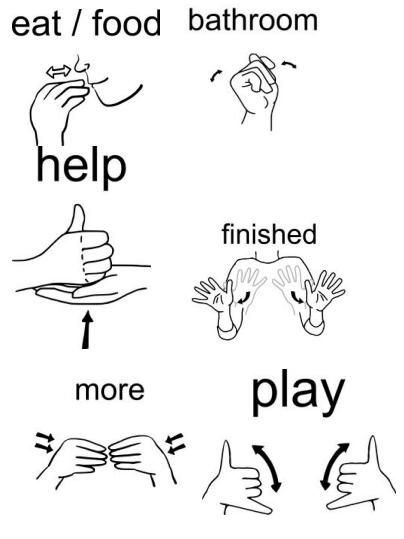 Makaton allows children to perform poetry and songs using gestures. By the way, teachers and parents love gesture songs no less than children! Also, I am a regular Macathon user with my kids. This inspires great confidence and desire for the parents of our wards to also use this program.
Makaton allows children to perform poetry and songs using gestures. By the way, teachers and parents love gesture songs no less than children! Also, I am a regular Macathon user with my kids. This inspires great confidence and desire for the parents of our wards to also use this program.
Elena Lyanguzova
Head of the Center for Supporting Families with Children with Developmental Disabilities "The Way of Kindness", Kirov, mother of Milia and Vanya The Makaton language program has taken root in our Center. It provides an opportunity to establish the first verbal contact with the child. Do you want more? All children know this gesture. There is one more gesture that almost everyone remembers - this is "Candy", oh, how it motivates to communicate. Makaton can be started at any age. So, we actively use gestures and reinforcing symbols with young people from training and production workshops. You know, even with older people who have had a stroke (who have aphasia) and come to the Center for speech therapy, Makaton's gestures can be useful.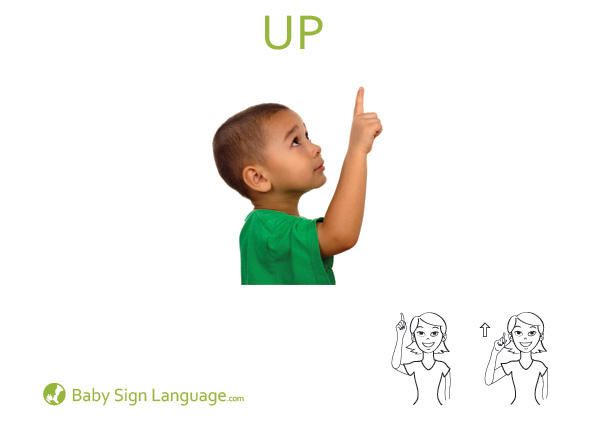 Makaton is not only gestures, it is also symbols, and most importantly, it is an opportunity to just talk. Recently, we had a traditional concert where the guys learned a song with gestures, and how happy they were that they could also perform and sing, albeit with their hands.
Makaton is not only gestures, it is also symbols, and most importantly, it is an opportunity to just talk. Recently, we had a traditional concert where the guys learned a song with gestures, and how happy they were that they could also perform and sing, albeit with their hands.
Natalia Kaliman
director of the ANO Diaconal Center "Touch", Orenburg", experts advised to try Makaton. Arman did not have imitation of movements, so we started with cards. First we introduced them to food, then to other things. When imitation and echolalia appeared, we began to use gestures, reinforcing words with them. To be honest, at the beginning I had doubts that the program works, and there was a delusion that it would interfere with the appearance of active speech.But now I am very glad that we tried Makaton.Arman's speech only appears and when he forgets what word to say, showing a gesture, I I help him to remember.Thank you very much to the specialists of the Center for getting to know Makaton, for their support and qualified assistance in mastering it!!!0217
Lilit
Arman's mother, Kirov As a speech therapist, I have always been in the mood for speech.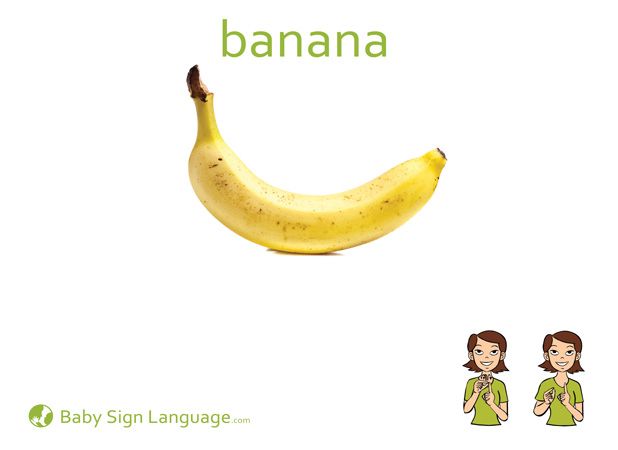 Therefore, when I started working with special children, I was afraid that Makaton would replace sound speech, and they would never reach this level. Then I realized that other professionals and parents have such a fear. However, after working for a while, I began to understand. Firstly, all people - and children - are conformists, it is important for us to be like everyone else. Therefore, if a person has the opportunity to use speech, he will use it. And if not? What then? Secondly, Makaton does not interfere, but helps the guys to speak. Communication becomes convenient from two sides: I speak, they understand me. Many children whose speech is difficult to understand at this stage can more easily express their thoughts by helping themselves with gestures. In addition, Makaton helps them remember a certain word. First they show a gesture, then they remember the word. And at some point, the need for a gesture disappears, and only the word remains.
Therefore, when I started working with special children, I was afraid that Makaton would replace sound speech, and they would never reach this level. Then I realized that other professionals and parents have such a fear. However, after working for a while, I began to understand. Firstly, all people - and children - are conformists, it is important for us to be like everyone else. Therefore, if a person has the opportunity to use speech, he will use it. And if not? What then? Secondly, Makaton does not interfere, but helps the guys to speak. Communication becomes convenient from two sides: I speak, they understand me. Many children whose speech is difficult to understand at this stage can more easily express their thoughts by helping themselves with gestures. In addition, Makaton helps them remember a certain word. First they show a gesture, then they remember the word. And at some point, the need for a gesture disappears, and only the word remains.
Olga Pugacheva
speech therapist, center "On the Road of Kindness", Kirov And so I passed the basic training on Makaton at the CLP. I am very proud of this and I am very glad that now I have a large number of concepts and techniques for teaching children. I have studied a lot in my life, spent many hours of all kinds of lectures in different educational institutions, but I have never been so interested in studying as in these two days! The knowledge has been gained and now I can't wait to start putting it into practice. My very first Makaton user is, of course, Seraphim. With Sima for a month now we have been actively using gestures iii - ta-dam! We observe a leap in the development of sounding speech. Don't believe the myth that gestures slow down speech! This is not true, there are even studies on the positive impact of the use of gestures on the formation of sounding speech. The next user, I hope, will be one beautiful girl with ASD, and there will also be a little boy with Down syndrome. Well, we'll see, maybe there will be more students! I really hope that I can help the guys start to communicate and speak
I am very proud of this and I am very glad that now I have a large number of concepts and techniques for teaching children. I have studied a lot in my life, spent many hours of all kinds of lectures in different educational institutions, but I have never been so interested in studying as in these two days! The knowledge has been gained and now I can't wait to start putting it into practice. My very first Makaton user is, of course, Seraphim. With Sima for a month now we have been actively using gestures iii - ta-dam! We observe a leap in the development of sounding speech. Don't believe the myth that gestures slow down speech! This is not true, there are even studies on the positive impact of the use of gestures on the formation of sounding speech. The next user, I hope, will be one beautiful girl with ASD, and there will also be a little boy with Down syndrome. Well, we'll see, maybe there will be more students! I really hope that I can help the guys start to communicate and speak
Maria Malova
Sima's mother Makaton is our assistant for reproducing long and difficult words, such as "please".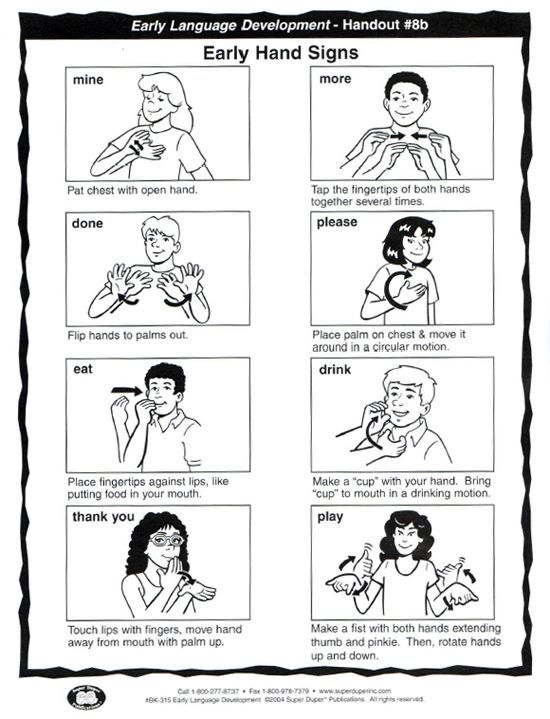 With the help of Makaton symbols, we develop coherent speech, compose short thematic stories for the school. Based on them, Masha can build a phrase on her own. She likes the Makaton symbols very much. They are concise and at the same time understandable. I regret that we did not get acquainted with this program at an early age. I think that my daughter's communication problems would then be solved easier and faster.
With the help of Makaton symbols, we develop coherent speech, compose short thematic stories for the school. Based on them, Masha can build a phrase on her own. She likes the Makaton symbols very much. They are concise and at the same time understandable. I regret that we did not get acquainted with this program at an early age. I think that my daughter's communication problems would then be solved easier and faster.
Larisa
Masha's mother I was introduced to the program among 11 other employees three years ago. At first, it was not very clear how the program could help us in our work, how children with severe intellectual disabilities could master it, etc. After the training, I became interested: will “my” children be able to master at least something, at least a small fraction of this program. I began slowly, in doses, to acquaint them with new information. We began to get acquainted with the gestures that we need in everyday life (food, toilet). The children looked at me with incomprehension: “What are you doing, and why do we need this?”.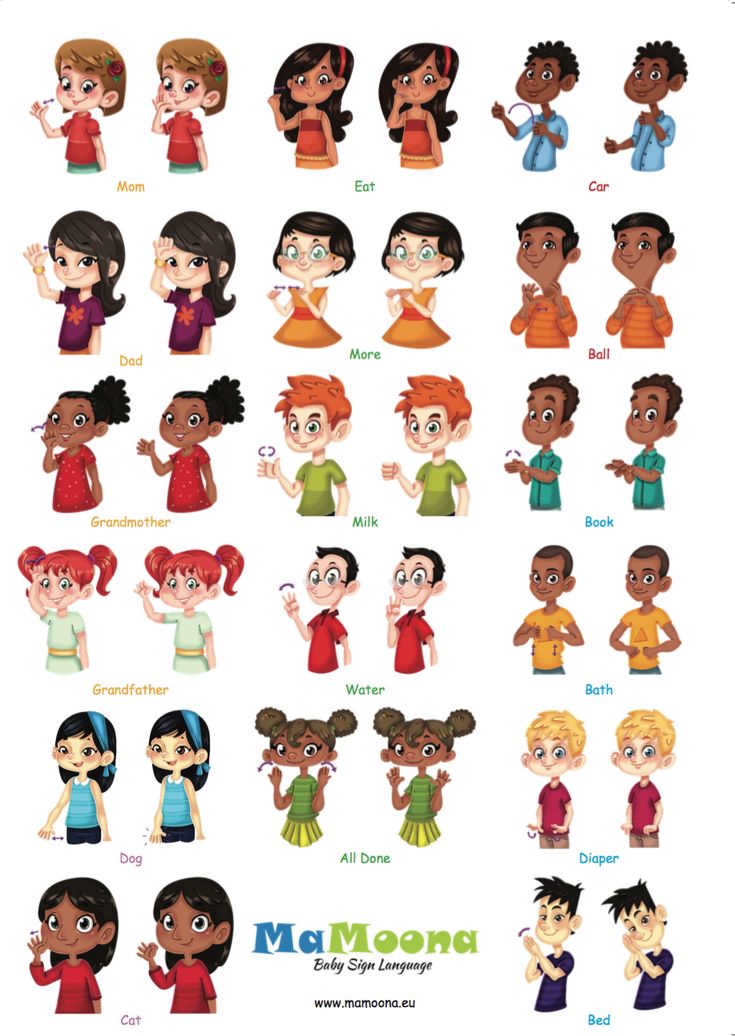 I decided to record on video each of our classes, and then together with the children we watched what happened. The children, looking at themselves from the outside, realized that they were not just waving their hands, but that they began to understand each other better. Slowly, slowly, but we got off the ground. Then I saw how colleagues from Moscow performed the song with the help of gestures and decided to try to repeat it with my children. I found a song, learned with the guys the gestures of the first verse and chorus, each one was allocated “his part” of the song that needs to be performed. We studied for a long time, it was difficult, nothing worked. Somehow managed, performed first for themselves. Then guests came to us, and we "sang" for them. And that’s it… Some kind of “toggle switch” worked, something clicked. The guys understood the meaning of a large number of new words and actions for them, they saw that they were easily understood by others, friends, honey. workers, cooks.
I decided to record on video each of our classes, and then together with the children we watched what happened. The children, looking at themselves from the outside, realized that they were not just waving their hands, but that they began to understand each other better. Slowly, slowly, but we got off the ground. Then I saw how colleagues from Moscow performed the song with the help of gestures and decided to try to repeat it with my children. I found a song, learned with the guys the gestures of the first verse and chorus, each one was allocated “his part” of the song that needs to be performed. We studied for a long time, it was difficult, nothing worked. Somehow managed, performed first for themselves. Then guests came to us, and we "sang" for them. And that’s it… Some kind of “toggle switch” worked, something clicked. The guys understood the meaning of a large number of new words and actions for them, they saw that they were easily understood by others, friends, honey. workers, cooks.